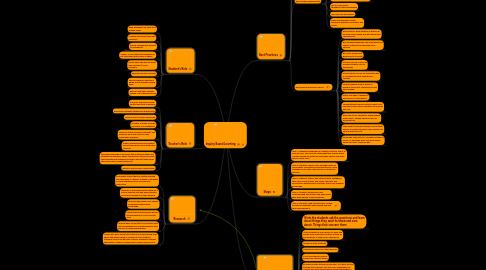
1. Student's Role
1.1. Build knowledge on what they already know
1.2. Propose and pursue their own questions
1.3. Active, independent learners (investigators)
1.3.1. Devise their own way to report their findings to class mmbers
1.4. “Inquiry is something that students do, not something that is done to them.”
1.5. Devise their own way to report their findings to class members
1.6. explorers of new concepts
1.7. asks and answers questions based on the teachers' lesson topic
1.8. partners with their teacher instead of just being lectured
2. Teacher's Role
2.1. A mentor and guide, giving as little direction as possible
2.2. Encourages student thinking and questioning
2.3. Allow students to have ownership
2.4. Provides a variety of levels and paths of investigation
2.5. Shows an active interest in students and promotes an active quest for new information and ideas
2.6. assigns students to groups in which students will work best in with other students
2.7. a trusted partnership is formed in this method between the students and teachers, where students can easily and freely communicate with teachers and other students(that is why this method ties in with partnering)
2.8. monitors and assesses student work
3. Research
3.1. Found that student gains in factual learning are equivalent or superior to those of students in more traditional forms of classroom instruction
3.2. Students scored significantly higher on a critical-thinking test and demonstrated increased confidence in their learning
3.3. Students developed more flexible and useful mathematical knowledge.
3.4. Students performed equally well on standardized test scores of basic skills.
3.5. findings have found that it encourages more active engagement in learning because they are able to enjoy learning more
3.6. researchers have found that students are more willing to go above and beyond what is required to learn with the standard curriculum with this method, because it is things that matter to them and they want to know more about it.
4. Best Practices
4.1. Projects are realistic, not school-like
4.2. A significant time investment for planning, implementation, and evaluation
4.3. Team-teaching
4.4. Well-designed assignments
4.4.1. are open-ended, global, and abstract in nature
4.4.2. focus on key elements of the discipline
4.4.3. help students remember enduring truths, even after they have forgotten the specific facts
4.4.4. recur several times throughout the investigation
4.4.5. have real-life applications
4.4.6. guide the students to other important questions, problems, and issues
4.5. best ways to implement this is?
4.5.1. have students work together in groups all the time and put each one with those they can work best
4.5.2. give students tasks they can experiment and explore instead of just handing them material
4.5.3. give clear assignment guidelines to students
4.5.4. let them use any resources available to them such as technology
4.5.5. provide plenty of one-on-one instruction if a student does not understand a concept.
4.5.6. monitor student work as much as possible, to prevent students from not participating
4.5.7. notice any signs of problems and address it immediately
4.5.8. collaborate with parents often and get them involved in their child's education as much as they can
4.5.9. avoid the use of 'objectives' when making lesson plans- instead, think of them as learning goals
4.5.10. avoid simply lecturing students, but let them explore the ideas themselves and continue to ask questions about it
4.5.11. encourage exploration of concepts outside of school, so that they don't just learn during school, but after school as well.
